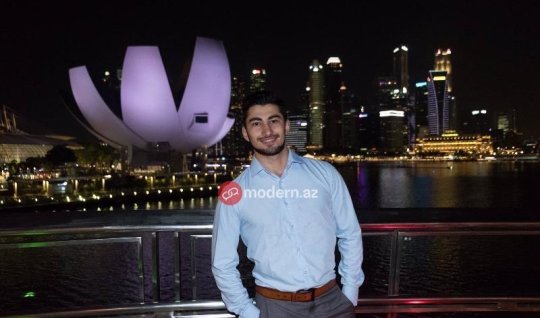The story of a will: Carpets left as a legacy by Sobu - PHOTO REPORT

Sobu village, located in the embrace of mountains in the southwest of Azerbaijan, is one of the unique settlements of Zangilan district, distinguished by its nature and history. Those who have seen this village say that if you visit Sobu once, you won't want to return. Situated amidst mountains, cool springs, and green forests, the village was also distinguished by its people – with a clean, pure lifestyle, longevity, and deeply rooted customs and traditions...
Modern.az website interviewed residents of Sobu village to learn interesting memories related to it. They looked back at past days, speaking both about the beauty of nature and the unique customs and traditions of the village.
Sobu-native mathematics teacher Elbrus Huseynov says that almost every beauty of nature exists in the village:

“Our village, with its springs, rich flora and fauna, dense forests, walnut trees, and fertile fields, resembles a living museum of nature. In the village, consisting of 30 households, there was a lifestyle formed over years: healthy eating, clean air, and most importantly, no mention of cigarettes or alcoholic beverages.”
According to Elbrus muallim, until the 1980s, there were neither smokers nor drinkers in Sobu.
“According to the elders, these harmful habits entered the village under the influence of two young guests who visited at some point. Although the cigarettes and drinks they brought were accepted by some young people, the main population of the village lived far from such habits.”
According to our interlocutor, one of the special features distinguishing Sobu village was that men wore “eshme bigh” (twisted mustache):

“This was not just an external appearance, but considered a symbol of pride, an example of masculinity. The elders of the village, even men aged 80-90, would ride horses to the forest and return loaded within 30-40 minutes. People lived such a healthy lifestyle in such a healthy nature, in a healthy environment,” E. Huseynov added.
Woven History – The Language of Carpets
Carpets – are examples of art that preserve the memory of an era, a people, a village.
The main essence of our photo report consists of handmade carpet samples woven in Sobu village of Zangilan in the last century.
 The carpets and weaving samples we see in the photos were prepared by Sobu village resident Ordak Hasanova.
The carpets and weaving samples we see in the photos were prepared by Sobu village resident Ordak Hasanova.
Her daughter Madina Jumshudova shared her impressions with us about the history of the carpets and her mother's will.
 According to our interviewee, the presented carpets date back to the 1950s of the 19th century, as well as to 1965 and 1982. These carpets, woven with her mother's painstaking effort, and handmade socks, remained entrusted to her as a legacy.
According to our interviewee, the presented carpets date back to the 1950s of the 19th century, as well as to 1965 and 1982. These carpets, woven with her mother's painstaking effort, and handmade socks, remained entrusted to her as a legacy.

“Before my mother passed away, she said that if Zangilan is liberated, these carpets should be returned to our homeland and given to a museum. Let them be a memento from me to my land, my people, my nation,” she stated.
Madina khanim also expressed that these carpets are not just household items, but also carry certain meanings and motifs:
“The carpets woven by my mother are known for their gazelle pattern, and this element is found only in carpets woven in Sobu village of Zangilan district. They are considered carpets with the "Asli and Kerem" motif, and these patterns, in turn, have become a symbol of the region's cultural identity.”
During the occupation of Zangilan by Armenian armed forces in 1993, the very last items taken when leaving the house were these carpets:
“I am glad that these carpets, which are my mother's handiwork and painstaking effort, are not thrown out or discarded. I am handing them over to our state,” she said with tears in her eyes.













-
11:41, Bu günAccusation from China: Japan interfered with military exercises
-
09:24, Bu günFire at a nightclub in India - THERE ARE FATALITIES
-
6 December 2025, 22:40We have reached an agreement with America - ZELENSKY
-
6 December 2025, 21:40Armenia and Azerbaijan border guards have removed helmets and bulletproof vests - PASHINYAN
-
6 December 2025, 20:00Ukraine no longer believes in empty promises
-
6 December 2025, 19:20“I am a 'Grey Wolf' and I will die this way! - Bağçalı
-
6 December 2025, 17:32In Russia 1 percent of men “DISAPPEARED”
-
6 December 2025, 17:13Negotiations concerning Gaza are passing through a decisive stage
-
6 December 2025, 16:51Will Putin's arrest warrant be annulled?
-
6 December 2025, 14:22Turkey–Azerbaijan energy corridor will provide incredible benefits - US Ambassador
-
6 December 2025, 13:50Horrific accident in Turkey - 6 people DIED
-
6 December 2025, 12:48Second Chernobyl?
-
6 December 2025, 09:15Ukraine's Commander-in-Chief Opposed Territorial Concession
-
6 December 2025, 08:26Students in Germany protested - “We don't want to be soldiers”
-
5 December 2025, 22:15The resolution of the Ukraine conflict is imminent...
-
5 December 2025, 19:43Assad's allies are preparing for rebellion
-
5 December 2025, 17:23Will Turkey open its borders with Armenia in 6 months? - REACTION from Ankara
-
5 December 2025, 16:23Kyrgyzstan wishes to become a member of the UN Security Council - CALL from Leaders
-
5 December 2025, 15:09The time has come for Northern Cyprus's full membership in the OTS - MINISTER
-
5 December 2025, 13:00Putin may meet with Trump - President's aide
-
5 December 2025, 11:44In Paris, Putin's “secret daughter” was found - “I am very sorry”
-
5 December 2025, 11:18AI-powered minister “was arrested”
-
5 December 2025, 11:16He/She, in the WC-2026 draw for Azerbaijan, represents
-
5 December 2025, 09:07Trump's National Security Strategy's priorities REVEALED
-
4 December 2025, 23:42Israel's participation in “Eurovision 2026” was confirmed
-
4 December 2025, 22:42Does Putin want to restore the USSR?
-
4 December 2025, 21:26Russia also blocked "SnapChat"
-
4 December 2025, 20:39Unknown drones reportedly pursued Zelensky's plane
-
4 December 2025, 16:46Abbas Araqchi visits Azerbaijan
-
4 December 2025, 16:44Mirzoyan met with Hakan Fidan in Vienna























































